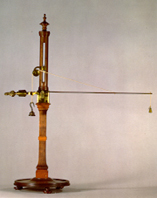
76.8 x 63.1 x 25.3
Carved wood and brass
INDEX 1788 : G.I.119
Machina, qua ostenditur quid valeant vires obliquae, si vecti tertii generis aptentur; inservit etiam ad vires Musculorum aestimandes.
Machine by which the value of oblique forces is shown if they are applied to a lever of the third type. It also serves to measure the forces of muscles.
This apparatus is for the study of the condition of equilibrium of the interpotent lever. It is composed of a wooden base from which rises a column made of two removable pieces. There is a groove in the upper part of the column in which a pulley can be fixed in different positions. In the middle of the column is a piece of brass with a bolt on it, that serves as the fulcrum for the lever.
The lever is made of brass, the smaller arm taking the form of an elongated ring through which a string can be passed to suspend a body. This string passes through the pulley mounted on the column, and its other end passes through a small hole in the bigger arm of the lever, exerting a force there whose direction can be controlled by moving the pulley along the groove in the column. A small weight is suspended from a string at the end of the bigger arm of the lever.
Using this apparatus it is possible to show the functioning of the mechanism of the human arm when it lifts a body in an extended position.
From Colégio dos Nobres, catalogue n.º 111.
Musschenbroeck, Peter van, Introductio ad Philosophiam Naturalem, Leiden, 1672, § 432, Tab. VI, Fig. 2.